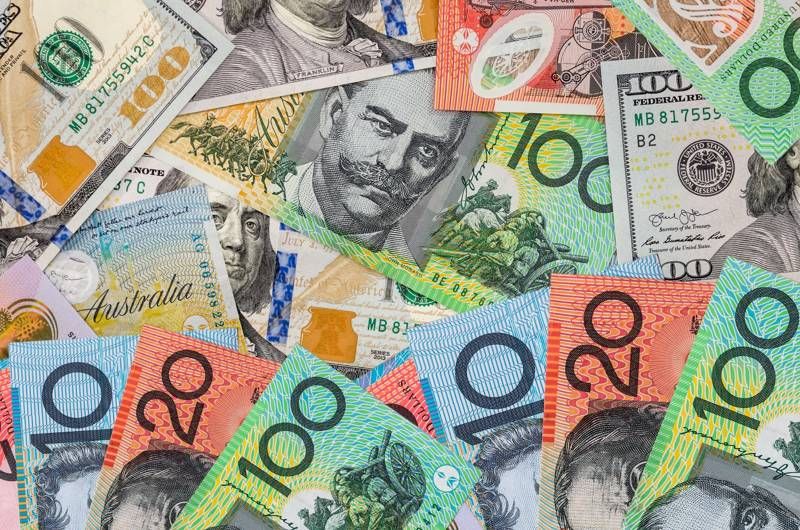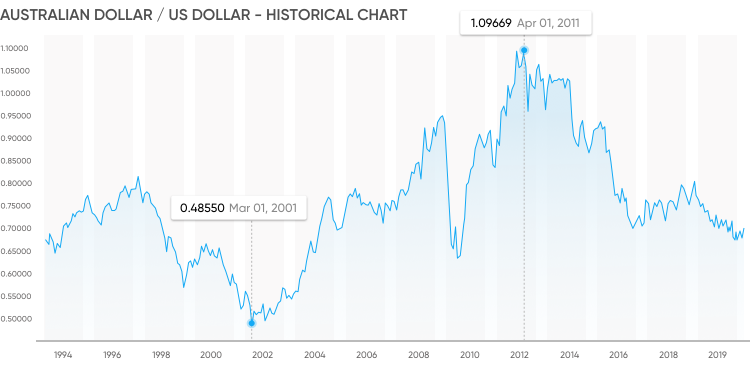Your guide to trading the AUD/USD Forex pair

Why is the AUD/USD an important market?
The Australian to US dollar (AUD/USD) pairing, informally known as the ‘Aussie’, is a popular forex pair and represents around five percent of the entire fx market by volume. Day traders can often witness high levels of both volume and volatility due to the interest rate disparity of both currencies.
In this market, the Australian dollar is the base currency, and the US dollar is the quote currency. This means the AUD/USD price at any time is the amount of US dollars one Australian dollar will buy.
AUD/USD trading hours
Theoretically you can trade forex pairs 24/7, but there are prime times to trade the AUD/USD when the currency pair is more volatile. The Aussie dollar to US dollar trading hours are generally busy between between 19:00 and 04:30 (GMT).
History of AUD/USD
The Australian dollar replaced the Australian pound. For decades, the Australian pound was pegged to Sterling until the Sterling devaluation in 1931. In the 1960s, the country decided to move forward with the Australian Dollar – a decimal currency – instead of the old imperial system.
The Australian-China trade relations, with Australia running a large trade surplus, is historically one of the factors that props-up the AUD. This relationship continues to play a prominent role in the rise and fall of the AUD.
The AUD/USD is the fifth most traded currency pair, but is not one of the six pairings that comprise the the US dollar index (USDX). The Australian economy is a big exporter of coal and iron-ore, hence it is highly dependent on commodity prices, which is another factor that historically affects the value of the AUD.
See the AUD/USD historical chart below:
Factors influencing the AUD/USD
Trade-relations: Australian-US trade relations are unsurprisingly a big influence on the AUD/USD currency pair. Australia and the US have a close economic relationship, and are trusted trade and investment partners. More than A$860.9 billion worth of inward foreign investment is from the United States. The trade agreement underpinning this relationship is the Australia-United States Free Trade Agreement (AUSFTA) that came into effect in 2005. Since AUSFTA, the export of US goods to Australia has increased by over 91%.
Interest-rate differential: The Aussie dollar to US dollar pairing is affected by both interest rates of the respective currencies, set by the Reserve Bank of Australia and the US Federal Reserve. The Reserve Bank of Australia reviews the interest rate every month, whereas the US Federal Reserve reviews rates eight times a year. The interest rate differential will affect the value of the AUD/USD exchange rate. For instance, if the Federal Reserve were to increase the interest rate, money may flow into the US strengthening the US dollar, and consequently weakening the AUD/USD rate.
How to trade the AUD/USD CFDs
The popularity of the AUD/USD currency pair has increased in the last few years due to the Australian commodities boom that occurred after 2000. This currency pair connects two influential and expanding economies. An individual can trade Aussie dollar to US dollar pairing with either a forex contract or alternatively, they can trade a contract for difference (CFD) on a particular currency pair, and speculate on the price difference.
A CFD is a financial instrument, typically between a broker and an investor, where one party agrees to pay the other the difference in the value of a security, between the start and end of the trade. You can either hold a long position (speculating that the price will go up) or a short position (speculating that the price will fall). This is considered a short-term investment or trade as CFDs tend to be used within a limited timeframe.
For instance, to trade the AUD/USD currency pair using CFDs, you speculate on the direction of the underlying asset. If you think the Australian dollar will rise then take a long position by buying the CFDs. If you think the Australian dollar will lose value versus the US dollar then you would take a short position by selling CFDs.
CFD trading offers great opportunities with a reliable CFD broker. Sign up at Capital.com and access the most popular global markets via our web platform or our ultimate trading app.
Need more support? Try our step-by-step forex course to guide you through the basics to the advanced concepts and explore potential profits and losses on your forex CFD trades with our free forex profit calculator.
Trade Australian Dollar / US Dollar CFD
Why trade AUD/USD CFDs with Capital.com
Advanced AI technology at its core: a Facebook-like news feed provides users with personalised and unique content depending on their preferences. If a trader makes decisions based on biases, the innovative SmartFeed offers a range of materials to put him back on the right track. The neural network analyses in-app behaviour and recommends videos, articles, news to polish your investment strategy.
Trading on margin: providing trading on margin (20:1 for AUD/USD), Capital.com gives you access to the AUD/USD pair using CFDs.
Trading the difference: by trading CFDs on AUD/USD, you speculate on the rise or fall of its price. CFDs trading is no different from traditional trading in terms of its associated strategies. A CFD trader can go short or long, set stop and limit losses and apply trading scenarios that align with their objectives.
All-round trading analysis: the browser-based platform allows traders to shape their own market analysis and forecasts with sleek technical indicators. For instance, a trader could choose to have AUD/USD analysis and AUD/USD forecasts as a big part of their feed. Capital.com provides live market updates and various chart formats, available on desktop, iOS, and Android.
Focus on safety: Captal.com puts a special emphasis on safety. Licensed by the FCA, ASIC & CySEC, it complies with all regulations and ensures that its clients’ data security comes first. The company allows to withdraw money 24/7 and keeps traders’ funds across segregated bank accounts.
FAQ
What are the AUD/USD highs and lows?
The AUD/USD pair historical all-time low is 0.4855 - it reached this value on 1 March 2001, partly due to a slowing in the Australian economy. Whereas, the all-time high is 1.09669, which was reached on 1 April 2011.
